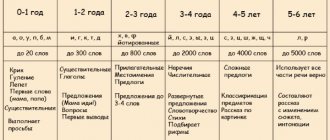The mental development of a child is a very complex, subtle and lengthy process, which is influenced by many factors.
An idea of how this or that stage goes will help you not only better understand your child, but also notice developmental delays in time and take appropriate measures. The generally accepted periodization of the development of the child’s psyche was developed by the Soviet psychologist Daniil Borisovich Elkonin. Even if you have never encountered his works, this system is familiar to you: in the annotations to children's publications it is often indicated that this work is “for preschool age” or “for primary schoolchildren.”
Elkonin’s system describes the mental development of a child from infancy to 15 years, although in some of his works the age of 17 years is indicated.
According to the scientist, the characteristics of each stage of development are determined by the leading activity of the child at a particular age, within the framework of which certain mental new formations appear.
Infancy
This stage covers the period from birth to one year. The leading activity of the baby is communication with significant figures, that is, adults. Mainly mom and dad. He learns to interact with others, express his desires and respond to stimuli in ways accessible to him - intonation, individual sounds, gestures, facial expressions. The main goal of cognitive activity is knowledge of relationships.
The task of parents is to teach the child to “communicate” with the outside world as quickly as possible. Games for the development of large and fine motor skills and the formation of a color scheme will help with this. Among the toys there must be objects of various colors, sizes, shapes, textures. Until one year, the child does not experience any experiences other than natural ones: hunger, pain, cold, thirst, and is not able to learn the rules.
What are unconditioned reflexes?
The unconditioned reflexes of a newborn are, first of all, nature-programmed responses and protective reactions to external stimuli that are necessary for the child’s life. Without these reflexes, the child would not be able to find the nipple and take the breast, or carry out the correct sucking movements. Almost all unconditioned reflexes are formed by the time of birth and persist from 1.5 to 4–5 months of a child’s life, giving way to the development of conscious motor skills. Longer preservation of a newborn's reflexes prevents the formation of these skills and is a manifestation of pathology.
So what unconditioned reflexes are characteristic of a newborn? Let's list
- search reflex (when stroking the corner of the mouth, the child turns his head in this direction and tries to touch the stimulus with his tongue);
- sucking reflex (when any object enters the child’s mouth, the baby grabs it with his lips and begins rhythmic sucking movements);
- Babkin's palm-oral reflex (when pressing on the palm, the child opens his mouth);
- Moro reflex (when hitting the surface on which the child is lying, he first spreads his arms to the sides, and then makes a grasping movement and brings his arms to the body);
- grasping reflex (when pressing on the palm, the child squeezes his fingers);
- support reflex (when the child’s legs touch the support, he first presses them in, and then straightens them and leans on the surface);
- automatic gait reflex (in an upright position with the body slightly tilted, the child begins to step with his feet on the table surface);
- protective reflex (when the baby is placed on his stomach, he turns his head to the side);
- Bauer's crawling reflex (in a position lying on his stomach with his feet resting, the child begins to crawl forward, alternately moving his arms and legs).
Assessing the state of the newborn's unconditioned reflexes is one of the main points of examining the newborn, especially if this examination is carried out by a neurologist. Changes in these reflexes, their weakening or absence, rapid exhaustion (the first time the reflex can be evoked, with subsequent irritations it is expressed less and less) can be observed with prematurity or immaturity, with birth damage to the nervous system, in the presence of a general infectious disease or other pathology of the period newborns.
Early childhood
It lasts from 1 year to 3 years. The leading activity is manipulative-objective activity. The child discovers many objects around him and strives to explore them as quickly as possible - taste them, break them, etc. He learns their names and makes his first attempts to take part in the conversation of adults.
Mental new formations are speech and visual-effective thinking, that is, in order to learn something, he needs to see how this action is performed by one of the elders. It is noteworthy that at first the child will not play independently, without the participation of mom or dad.
Features of the early childhood stage:
- comprehension of the names and purposes of objects, mastering the correct manipulation of a specific object;
- mastering established rules;
- the beginning of awareness of one’s own “I”;
- the beginning of the formation of self-esteem;
- gradual separation of one’s actions from the actions of adults and the need for independence.
Early childhood often ends with the so-called crisis of 3 years, when the child sees pleasure in disobedience, becomes stubborn, literally rebels against established rules, sharp negative reactions increasingly appear, etc.
Features of the nervous system of a newborn
In the first days of a newborn's life, the excitability of his nervous system is significantly reduced. This is necessary so that the abundance of irritating factors, sudden changes in environmental conditions, and intense stress during childbirth do not cause damage to the nervous system. During the first week of a child's life, excitability gradually increases.
One of the features of the nervous system of a newborn is that its efficiency is low: fatigue and exhaustion of nervous functions occurs much faster than in adults, so children cannot endure monotonous irritations for a long time, for example, they quickly cease to be interested in a rattle and need a change of impressions, for example, conversations with mom, soft music. But these impressions should not be excessive, since their abundance and great intensity can also cause fatigue and overstimulation. The nervous system of a newborn is more sensitive to a lack of oxygen due to the high level of metabolic processes, which require high blood oxygen saturation. This is associated with the vulnerability of the nervous system of the fetus and newborn to hypoxia (lack of oxygen) during childbirth and during the first days after birth.
During intrauterine development, the fetal muscles are constantly in a state of flexion, which ensures the characteristic fetal position. After the birth of a child, the predominance of the tone of the flexor muscles remains in his skeletal muscles, that is, the baby constantly strives to occupy the so-called fetal position, but the activity of the motor centers that provide the tone of the extensor muscles gradually increases. Thanks to this, active movements become possible.
All movements of the fetus and newborn child are in the nature of reflexes and extend to the entire body. At this age, the baby is not yet able to carry out purposeful movements - his movements are chaotic and are a response to some kind of irritation.
Another very interesting and important feature of the function of the nervous system of a newborn is that all his behavior is subject to food dominance: if the child is hungry, his reflexes are inhibited, and his excitability is further reduced. He needs only one thing - to satisfy his immediate need for food.
Particular attention should be paid to the peculiarities of the nervous system of a newborn, associated with incomplete myelination of nerve fibers. Myelination is the process of formation of a special sheath covering the nerve endings. This membrane plays the role of a kind of insulation, ensuring the spread of a nerve impulse from a nerve cell to an organ or muscle, but not to a muscle group. Since by the time of birth not all nerve endings have a myelin sheath, any nerve impulse passing through a nerve bundle, which combines many nerve fibers, spreads to neighboring fibers. This is due to the fact that any excitation becomes more or less general, affecting neighboring muscles or organs. So, if a newborn experiences discomfort or pain, this signal is “transmitted” to the entire body. This is one of the reasons for such pronounced anxiety in a child due to intestinal colic: abdominal pain spreads to neighboring organs.
A striking example of the generalization of a nerve impulse is the unconditioned reflexes of a newborn. For example, when running a finger along the spine, the body is straightened, arms and legs are bent, a cry is heard, and even sometimes urination occurs.
In the early stages of development in a growing organism, the nerve centers have a high degree of ability to compensate for adaptation. If the activity of any center is disrupted, its function is taken over by other parts of the brain or spinal cord. This ability helps restore some functions of victims as a result of an unfavorable course of the intrauterine period. This truly lucky ability of the brain makes it possible to use many of its reserve capabilities to ensure the proper development of the child.
Thus, the nervous system is small: by the time of birth, it is already largely formed, its structure practically does not differ from that of an adult, but those parts of it that are responsible for the highest and most complex activities are still very immature. Their maturation lasts throughout the first year of a child’s life.
Preschool age
This stage begins at 3 years and ends at 7 years. The leading activity for preschoolers is play, or rather, role-playing game, during which children learn relationships and consequences. The personal sphere of the psyche is actively developing. Age-related neoplasms are a need for social significance and activity.
The child can move independently, his speech is understandable to adults, and he often feels like a full participant in communication.
- He understands that all actions and actions have a specific meaning. When teaching, for example, hygiene rules, explain why this is necessary.
- The most effective way to absorb information is through play, so role-playing games should be played every day. In games, you should not use real objects, but their substitutes - the simpler the better for the development of abstract thinking.
- The preschooler experiences an urgent need to communicate with peers and learns to interact with them.
Towards the end of the stage, the child gradually gains independence, is able to determine the cause-and-effect relationship, is able to take responsibility for his actions, and obeys the rules if he sees them as reasonable. He learns good habits, rules of politeness, norms of relationships with others, strives to be useful, and willingly makes contact.
Junior school age
This stage lasts from 7 to 11 years and is associated with significant changes in the child’s life and behavior. He enters school, and play activities give way to educational activities. The intellectual and cognitive sphere is actively developing. Age-related mental neoplasms: voluntariness, internal plan of action, reflection and self-control.
What does it mean?
- He is able to concentrate for a long time on a specific lesson: sit quietly at his desk during a lesson and listen to the teacher’s explanations.
- Able to plan and perform tasks in a certain sequence, for example, when doing homework.
- He determines the boundaries of his knowledge and identifies the reason why, for example, he cannot solve a problem, what exactly is missing for this.
- The child learns to control his actions, for example, first do his homework, then go for a walk.
- He experiences discomfort from the fact that an adult (teacher) cannot give the amount of attention that he is used to receiving at home.
A younger student can more or less accurately assess the changes that have occurred in his personality: what he could do before and what he can do now, learns to build relationships in a new team, and obey school discipline.
The main task of parents during this period is to emotionally support the child, closely monitor his mood and feelings, and help him find new friends among classmates.
First skills
Nervous system of the newborn As mentioned above, by the time the baby is born, the spinal cord is the most mature. The brain, as a more complex structure, by the end of the prenatal period has not yet completed its development, not only morphologically (the formation of convolutions of the cerebral cortex continues, the ratio of the white and gray matter of the brain changes), but also functionally. So, a very important point is that the number of nerve cells in the cerebral cortex of a newborn child and an adult is the same. But in a newborn, these cells are still immature in their structure; they have very few processes connecting the cortical cells with each other, and it is the presence of these connections that determines many functions of higher nervous activity, such as memory, emotions, and skills.
However, the development of the cerebral cortex occurs quite quickly, and we notice this by how quickly the baby changes. A newly born baby is not yet able to hold his head and fix his gaze, he can only distinguish bright light and sees his mother’s face as a blurry spot, all his movements are chaotic and unconscious. But a month passes and the child makes significant progress in his development. First of all, all senses are improved.
In the first month of a baby’s life, the movements of his eyeballs are not yet coordinated; from time to time, convergent or divergent strabismus is noted. But by the fifth week, the child already focuses his gaze quite well on a specific object, thanks to which he can clearly see surrounding objects and faces. By this age, he begins to understand that all the positive emotions in his life are associated with the face he sees most often - saturation, warmth, comfort. Most often this is the face of his mother. Accordingly, the baby sees a direct connection between the appearance of the mother’s face and the appearance of comfort, saturation and warmth. This becomes the beginning of the formation of positive emotions.
The hearing organ functions already in the last weeks of intrauterine development. The fetus may experience increased heart rate in response to sharp sounds and... on the contrary, the normalization of the heartbeat and bioelectrical activity of the brain when listening to melodic music. In a newborn, the reaction to sound is in the nature of an indicative reflex: in response to a sound stimulus, the child can close his eyes, open his mouth slightly, shudder and hold his breath.
The taste organ is also fully formed at the time of birth: the newborn is good at distinguishing sweet from sour, bitter or salty. When a sweet substance enters a child's mouth, he begins to make sucking movements. Bitter, sour or salty substances cause a grimace of displeasure, closing the eyes, and crying.
By the end of the first month of life, the child acquires skills such as the ability to follow a bright moving object with his eyes, recognize his mother and smile at her. respond to the mother's voice. His daily routine is still dominated by periods of sleep, while during wakefulness - negative emotions: in this way, the baby signals hunger, discomfort associated with overexcitation or fatigue, and wet diapers. But gradually, periods of calm wakefulness begin to appear in his emotional state, when the baby tries to look at surrounding objects, studies his mother’s face or listens to her voice. All this is the beginning of the formation of his psyche, his higher nervous activity, which becomes possible thanks to the rapid development of the cerebral cortex and sensory organs.
Adolescence
This is the “transitional age”, which lasts from 11 to 15 years and the onset of which all parents await with horror. The leading activity is communication with peers, the desire to find one’s place in the group, receive its support and at the same time stand out from the crowd. The need-motivational sphere of the psyche develops mainly. Mental neoplasms – self-esteem, desire for “adulthood”.
The teenager is torn between the desire to grow up quickly and to maintain a certain impunity for as long as possible, to relieve himself of responsibility for his actions. He learns about the system of relations between the sexes, tries to build his own, rebels against prohibitions and constantly breaks the rules, fiercely defends his point of view, seeks his place in the world and at the same time amazingly easily falls under the influence of others.
Some guys, on the contrary, immerse themselves in their studies, their transitional age is, as it were, “transferred” to a later time, for example, they may well begin their rebellion even after graduating from university.
Parents face a difficult task - to find a common language with a teenager in order to protect him from rash actions.
How to teach a newborn different skills
Learning is a process that leads to permanent changes in behavior based on experience. Babies learn in different ways.
Most often, the learning process looks like the use of rewards and/or punishments. Reinforcement reinforces desired behavior, while negative reinforcement shows which response is undesirable.
For example, a child who sees that smiling attracts parental attention smiles more at his parents.
Mostly, newborns learn through observation and imitation of others.
For example, a baby learns to clap by watching and imitating its older brother. This form of learning is the fastest and most natural way for children to acquire new skills.
Adolescence
Some psychologists identify another stage of mental development - this is adolescence, from 15 to 17 years. Educational and professional activities become the leading ones. Personal and cognitive spheres develop. During this period, the teenager matures sharply, his decisions become more balanced, he begins to think about the future, in particular, about choosing a profession.
Growing up is difficult at any age - at 3 years old, at 7, and at 15 years old. Parents must understand well the characteristics of their child’s mental development and help him successfully overcome all age-related crises, direct the formation of his character and personality in the right direction.
Date of publication: 06/26/2017. Last modified: 05/09/2018.
Table of weight and height of an infant by month (up to 1 year)
The table shows the average height and weight of infants (under 1 year of age) by month for boys and girls.
| Age | Girls | Boys | ||
| Weight, kg | Height, cm | Weight, kg | Height, kg | |
| Newborns | 3,33 ± 0,44 | 49,50 ± 1,63 | 3,53 ± 0,45 | 50,43 ± 1,89 |
| 1 month | 4,15 ± 0,54 | 53,51 ± 2,13 | 4,32 ± 0,64 | 54,53 ± 2,32 |
| 2 months | 5,01 ± 0,56 | 56,95 ± 2,18 | 5,29 ± 0,76 | 57,71 ± 2,48 |
| 3 months | 6,07 ± 0,58 | 60,25 ± 2,09 | 6,26 ± 0,72 | 61,30 ± 2,41 |
| 4 months | 6,55 ± 0,79 | 62,15 ± 2,49 | 6,87 ± 0,74 | 63,79 ± 2,68 |
| 5 months | 7,38 ± 0,96 | 63,98 ± 2,49 | 7,82 ± 0,80 | 66,92 ± 1,99 |
| 6 months | 7,97 ± 0,92 | 66,60 ± 2,44 | 8,77 ± 0,78 | 67,95 ± 2,21 |
| 7 months | 8,25 ± 0,95 | 67,44 ± 2,64 | 8,92 ± 1,11 | 69,56 ± 2,61 |
| 8 months | 8,35 ± 1,10 | 69,84 ± 2,07 | 9,46 ± 0,98 | 71,17 ± 2,24 |
| 9 months | 9,28 ± 1,01 | 70,69 ± 2,21 | 9,89 ± 1,18 | 72,84 ± 2,71 |
| 10 months | 9,52 ± 1,35 | 72,11 ± 2,86 | 10,35 ± 1,12 | 73,91 ± 2,65 |
| 11 months | 9,80 ± 0,80 | 73,60 ± 2,73 | 10,47 ± 0,98 | 74,90 ± 2,55 |
| 12 months | 10,04 ± 1,16 | 74,78 ± 2,54 | 10,66 ± 1,21 | 75,78 ± 2,79 |










